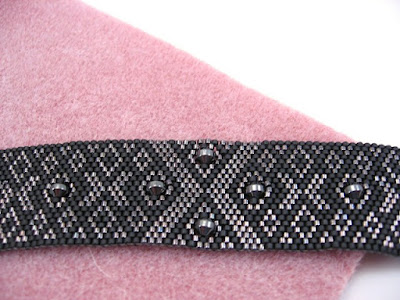I actually made this bracelet in January, but I've waited to post about it because I was planning to write a pattern and create a chart for it. Since that hasn't happened, I decided to post the pictures, and if I do write up the pattern later, I'll post it then.
This actually has an even longer history than the 11 months it's been waiting for me to post about it. Before that a friend commissioned me to make a bracelet to go with a necklace he already had. My first creation was this netted bracelet (there is more information on it in my old blog).
It broke soon after I made it, so I repaired it. It broke again. I blamed the way I'd attached the clasp and repaired it, adding a beaded clasp in the process. It broke again. I thought maybe the hematite beads were cutting the Nymo I normally use for netting, so I remade it altogether using Fireline instead. It broke again. I howled in frustration and decided it was time to go back to the drawing board for a whole new design.
And this was the result. I used Toho Treasure Japanese cylinder beads in matte black and gun metal and used the same bicone hematite beads from the original design. I've found peyote stitch to make very sturdy bracelets in the past, and this one has held up well also. Just in case the hematite beads do have a sharp edge, I used Fireline again to make this.
I used a sterling silver slide lock clasp with bars for attaching the beading. I absolutely love these for peyote stitch bracelets, since it allows for attaching a metal clasp very securely by wrapping part of the body of the bracelet around the bar and stitching it closed.
I'm pleased to report that this design seems to be more durable and has held up to repeated wear. While I was pretty frustrated with the original bracelet, it worked out in the end, since this design suits the style of the wearer and the inspiration bracelet much better. It was also fun designing a peyote pattern, working out how to include the bicone beads, and working in odd count peyote for the first time. I've been pretty intimidated by it for a long time, but it turned out to be easier than I'd thought. So, this was a great learning project in a lot of ways.




No comments:
Post a Comment